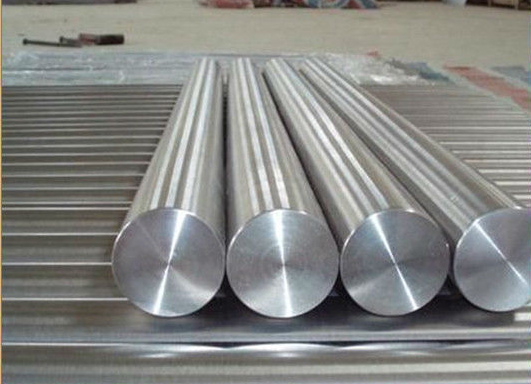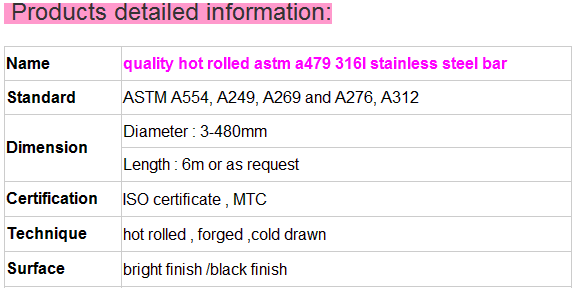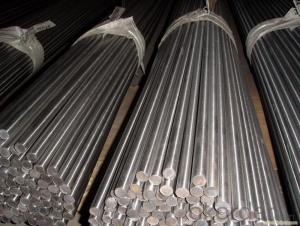quality hot rolled astm a479 316l stainless steel bar
- Loading Port:
- Tianjin
- Payment Terms:
- TT OR LC
- Min Order Qty:
- 100 kg
- Supply Capability:
- 1000 kg/month
OKorder Service Pledge
Quality Product, Order Online Tracking, Timely Delivery
OKorder Financial Service
Credit Rating, Credit Services, Credit Purchasing
You Might Also Like




- Q:Can stainless steel pipes be used in pharmaceutical industries?
- Yes, stainless steel pipes can be used in pharmaceutical industries. Stainless steel is highly resistant to corrosion, easy to clean, and does not react with most chemicals, making it a suitable material for pharmaceutical applications where hygiene and product purity are crucial.
- Q:Can stainless steel pipes be used for pharmaceutical industries?
- Yes, stainless steel pipes can be used for pharmaceutical industries. Stainless steel is a common material used in the pharmaceutical industry due to its excellent corrosion resistance, durability, and hygienic properties. It is resistant to chemicals, high temperatures, and moisture, making it suitable for various applications within pharmaceutical manufacturing processes. Stainless steel pipes are often used for transporting and storing pharmaceutical products, as well as for the distribution of purified water, steam, and other fluids. Additionally, stainless steel is easy to clean and maintain, which is crucial in ensuring the cleanliness and sterility required in pharmaceutical facilities.
- Q:What is the difference between seamless and drawn-over-mandrel stainless steel pipes?
- Seamless stainless steel pipes are manufactured without any welding or seams, making them stronger and more resistant to corrosion. On the other hand, drawn-over-mandrel stainless steel pipes are produced by drawing a solid stainless steel bar over a mandrel, resulting in a welded seam that may be less durable and more prone to corrosion.
- Q:How do stainless steel pipes compare to copper pipes?
- Stainless steel pipes and copper pipes are both widely utilized in various applications, yet they possess distinct characteristics that differentiate them. The resistance to corrosion is one of the primary distinctions between stainless steel pipes and copper pipes. Stainless steel pipes exhibit exceptional corrosion resistance, rendering them suitable for environments with high humidity or chemical exposure. Conversely, copper pipes also possess corrosion resistance, albeit not to the same degree as stainless steel. They may gradually corrode when subjected to specific chemicals or acidic conditions. Cost is another aspect to consider. Copper pipes generally carry a higher price tag than stainless steel pipes. However, copper is an exceedingly efficient conductor of heat and electricity, making it a preferred option for heat transfer applications like plumbing and HVAC systems. Stainless steel pipes also exhibit good conductivity but are generally less expensive than copper pipes, making them a cost-effective alternative in many cases. Regarding durability, stainless steel pipes are renowned for their strength and ability to withstand high pressures, rendering them suitable for industrial applications and underground installations. Although copper pipes are also durable, they may be more susceptible to damage in extreme conditions or under excessive pressure. Ease of installation is another factor to take into account. Copper pipes are relatively easy to work with due to their malleability, enabling simple bending and shaping. Conversely, stainless steel pipes tend to be harder and necessitate specialized tools for cutting and bending. In conclusion, stainless steel pipes provide superior corrosion resistance, cost-effectiveness, and are ideal for high-pressure applications. On the other hand, copper pipes possess excellent heat transfer properties and are more malleable, making them suitable for plumbing and HVAC systems. Ultimately, the choice between stainless steel and copper pipes depends on the specific requirements of the application and budget constraints.
- Q:Are stainless steel pipes suitable for power plant systems?
- Stainless steel pipes prove to be a suitable option for power plant systems. Stainless steel is renowned for its exceptional ability to resist corrosion, a critical characteristic required in power plant systems. These systems expose pipes to elevated temperatures, pressures, and various corrosive elements like water, steam, and chemicals. The stainless steel pipes demonstrate remarkable resistance to rust, oxidation, and scaling, ensuring their reliability and durability over extended periods of time in power plant operations. Moreover, the stainless steel pipes possess considerable strength, enabling them to endure the high pressure and stress commonly encountered in power plant systems. Additionally, they exhibit outstanding heat resistance, a crucial feature given the extreme temperatures to which the pipes are exposed in power plants. In summary, due to their corrosion resistance, strength, and heat resistance properties, stainless steel pipes enjoy widespread popularity as a favored choice in power plant systems.
- Q:What is the difference between seamless and electric resistance welded stainless steel pipes?
- Seamless and electric resistance welded (ERW) stainless steel pipes vary in terms of their production process and the characteristics of the resulting pipes. Seamless stainless steel pipes are made through hot rolling or cold drawing. A solid cylindrical billet or ingot is heated and pierced to create a hollow tube. This tube is then elongated and reduced in diameter to achieve the desired size and thickness. Since seamless pipes lack any welding seam, they possess higher strength, corrosion resistance, and pressure resistance compared to welded pipes. They are commonly used in high-pressure applications due to their ability to withstand stress and resist leaks or failures. In contrast, electric resistance welded stainless steel pipes are manufactured by applying heat and pressure to longitudinally welded stainless steel strips or plates. The edges of the strip or plate are heated and fused together under pressure to form a tube. ERW pipes have a visible welded seam along their length due to the welding process. Although the welded seam may slightly diminish the overall strength and corrosion resistance of the pipe, ERW pipes are still highly durable and suitable for various applications. They are frequently utilized in industries such as oil and gas, petrochemical, and plumbing. To summarize, the primary distinction between seamless and electric resistance welded stainless steel pipes lies in their manufacturing process and the presence of a visible welded seam. Seamless pipes are produced without welding, resulting in superior strength and corrosion resistance, particularly in high-pressure applications. Conversely, ERW pipes are formed through welding, resulting in a visible seam, but they still possess good durability and are widely used in different industries.
- Q:How is stainless steel pipe different from carbon steel pipe?
- Stainless steel pipe and carbon steel pipe are two popular materials used in various industries for different applications. The main difference between these two types of pipes lies in their composition, corrosion resistance, and price. Firstly, stainless steel pipe is made up of an alloy of iron with a minimum of 10.5% chromium content. This addition of chromium forms a protective layer of chromium oxide on the surface of the pipe, which significantly enhances its corrosion resistance. On the other hand, carbon steel pipe is primarily composed of iron and carbon, with no additional alloying elements. This lack of alloying elements makes carbon steel pipe more susceptible to corrosion, especially when exposed to moisture or harsh environments. Secondly, stainless steel pipe is highly resistant to corrosion and rust, making it suitable for applications where the pipe needs to withstand harsh conditions or exposure to corrosive substances. Carbon steel pipe, on the other hand, is more prone to corrosion and may require additional protective coatings or treatments to prevent rusting. Lastly, the price of stainless steel pipe is generally higher than that of carbon steel pipe. This is mainly due to the added chromium content and the superior corrosion resistance it provides. Carbon steel pipe, being a more basic and common material, is generally more affordable and widely available. In summary, the key differences between stainless steel pipe and carbon steel pipe lie in their composition, corrosion resistance, and price. Stainless steel pipe offers superior corrosion resistance and durability, making it ideal for applications where corrosion is a concern. Carbon steel pipe, although less resistant to corrosion, is more affordable and widely used in various industries. The choice between these two types of pipes ultimately depends on the specific requirements, budget, and environmental conditions of the intended application.
- Q:Can stainless steel pipes be used for petrochemical applications?
- Yes, stainless steel pipes can be used for petrochemical applications. Petrochemical processes involve the handling and transportation of various corrosive and high-temperature substances, and stainless steel pipes offer excellent resistance to corrosion and high temperatures. Stainless steel is known for its ability to withstand aggressive chemicals, such as acids and alkalis, as well as its resistance to stress corrosion cracking. Additionally, stainless steel pipes are highly durable and have a long lifespan, making them suitable for the demanding conditions of petrochemical applications.
- Q:What is the welding procedure for stainless steel pipes?
- To achieve a strong and durable joint, stainless steel pipes undergo a specific welding procedure. Typically, the process entails several crucial steps. To begin, it is essential to choose the appropriate welding technique for stainless steel, which is often Tungsten Inert Gas (TIG) welding due to its ability to produce precise and clean welds. Before commencing the welding process, it is necessary to thoroughly clean the stainless steel pipes to eliminate any contaminants like dirt, grease, or oxidation. This can be accomplished using either a degreasing agent or a stainless steel wire brush. Following the cleaning process, the pipes must be aligned and fitted together correctly. It is crucial to ensure that the gap between the pipes remains consistent and even throughout the joint. This can be achieved by temporarily securing the pipes in place using clamps or tack welding. Once the pipes are properly aligned, the TIG welding process can commence. This involves using a TIG torch to create an electric arc between a tungsten electrode and the stainless steel pipes. The intense heat generated by the arc melts the edges of the pipes, creating a fusion between the base metal and the filler material. During the welding process, it is vital to maintain a stable arc length and control the welding speed to achieve a uniform weld bead. Regulating the heat input and controlling the welding parameters can be accomplished by utilizing a foot pedal or a remote control. Throughout the welding process, it is important to safeguard the weld area from contamination. This can be achieved by using shielding gas, such as argon, to establish an inert atmosphere around the weld zone. The shielding gas prevents the weld area from reacting with oxygen and other atmospheric elements that could result in weld defects. Upon completing the welding, it is advisable to perform post-weld cleaning and inspection. This involves removing any slag or spatter that may have formed during the welding process and visually examining the weld for any defects like cracks or discontinuities. In summary, the welding procedure for stainless steel pipes involves cleaning the pipes, aligning and fitting them together, TIG welding with the appropriate arc length and welding speed, shielding the weld area with inert gas, and conducting post-weld cleaning and inspection. By following these steps, a dependable and sturdy weld joint can be achieved for stainless steel pipes.
- Q:Can stainless steel pipes handle extreme weather conditions?
- Stainless steel pipes are renowned for their exceptional durability and ability to withstand the harshest weather conditions. They exhibit remarkable resistance to extreme temperatures, heavy rainfall, fierce winds, and even harsh chemicals, remaining corrosion-free and undeteriorated. The inherent qualities of stainless steel, including its superior strength, resistance to corrosion, and tolerance to heat, render it an optimal choice for outdoor applications and adverse weather circumstances. Stainless steel pipes effectively endure intense heat and cold, while effectively combating the detrimental effects of UV radiation and oxidation. These pipes find extensive use in industries encompassing oil and gas, chemical processing, construction, and marine applications, where they confront formidable environments. All in all, stainless steel pipes offer a dependable and enduring solution for handling the most severe weather conditions.
1. Manufacturer Overview |
|
|---|---|
| Location | |
| Year Established | |
| Annual Output Value | |
| Main Markets | |
| Company Certifications | |
2. Manufacturer Certificates |
|
|---|---|
| a) Certification Name | |
| Range | |
| Reference | |
| Validity Period | |
3. Manufacturer Capability |
|
|---|---|
| a)Trade Capacity | |
| Nearest Port | |
| Export Percentage | |
| No.of Employees in Trade Department | |
| Language Spoken: | |
| b)Factory Information | |
| Factory Size: | |
| No. of Production Lines | |
| Contract Manufacturing | |
| Product Price Range | |
Send your message to us
quality hot rolled astm a479 316l stainless steel bar
- Loading Port:
- Tianjin
- Payment Terms:
- TT OR LC
- Min Order Qty:
- 100 kg
- Supply Capability:
- 1000 kg/month
OKorder Service Pledge
Quality Product, Order Online Tracking, Timely Delivery
OKorder Financial Service
Credit Rating, Credit Services, Credit Purchasing
Similar products
New products
Hot products
Related keywords


























